The Ferdinand Sd.Kfz.184 was a 70 ton panzerjäger (tank hunter) armed with a 88mm Pak 43/2 L/71 main gun and used by the Germans during WWII. Its combat debut was during Operation Citadel (German: Unternehmen Zitadelle, AKA the Battle of Kursk) in July 1943 where it was misused as a direct assault weapon and suffered heavy losses.

Dr. Ferdinand Porsche submitted a design for a new 45-ton heavy tank, the VK 45.01 (P). In preparation for production, 100 chassis were built and 9 were used for prototypes. No spare parts were produced. During test trails at Berka, Germany, the VK 45.01 (P) competed against the Henschel identically-armed VK 45.01 (H) H1 prototype which proved to be superior in performance. In October 1942, the two entries were evaluated and the Henschel prototype was accepted for mass production which became the infamous Tiger I tank.
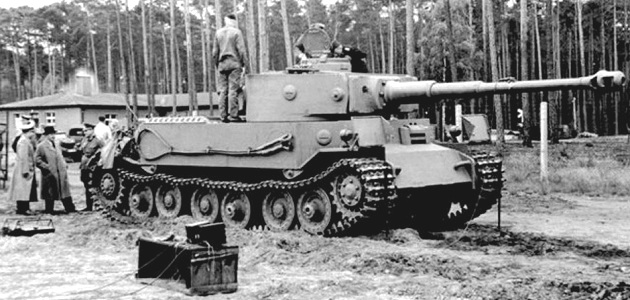
Ferdinand mit 21cm Beutemorse
An early proposal was to convert the VK 45.01 (P) chassis to be a Ferdinand Sturmgeschütz with a captured French 21cm mortar. But the French did not have a 21cm mortar in service. The French did had the Mortier de 220mm Tir Rapide (220mm Fast Shot Mortar) modèle 1915/1916 Schneider or the 220mm TR mle 1915/1916 for short. It was a French howitzer designed, produced and used during WWI. In 1939, the French army deployed 376 mle 1915/16s of the 462 that were still available. After the French surrendered in 1940, the Germans pressed the surviving pieces into service designated as the 22cm Mörser 530(b) and 22cm Mörser 531(f). Mörser is “mortar” in German. No prototype of the Beutemorse was produced.

Another configuration considered but not built was the VK 45.01 (P) chassis mounting a 15cm sFH 18.
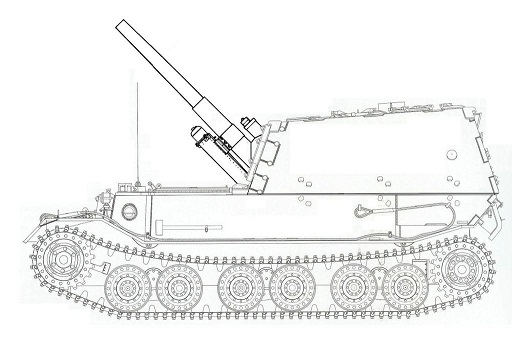
From March to May 1943, 91 VK 45.01 (P) chassis (numbers 150010 to 150100) were converted to the Panzerjäger Tiger (P) “Ferdinand”, Sd.Kfz.184.

Ferdinand combat debut – Operation Zitadelle
XXXXI Panzerkorps, 9th Army, Army Group Center (4 July 1943)
292. Infanterie-Division (508 and 509 PanzerGrenadier-Regiments)
18. Panzer-Division
86. Infanterie-Division (184 and 216 Infanterie-Regiments)
schwere Panzerjäger-Regiment 656
schwere Panzerjäger-Abteilung 653 (45 Ferdinands)
Panzerkompanie (Funklenk) 314 (Borgward B IVs)
Sturmgeschutz-Abteilung 244 (StuG IIIs and StuH 42s)
schwere Panzerjäger-Abteilung 654 (44 Ferdinands)
Panzerkompanie (Funklenk) 313 (Borgward B IVs)
Sturmgeschutz-Abteilung 177 (StuG IIIs and StuH 42s)
Sturmpanzer-Abteilung 216 (Brummbärs)
Note:
Funklenk kompanies were equipped with radio-controlled demolition carriers.
schwere Panzerjäger-Regiment 656 equipment overview on 4 July 1943
| Vehicle | Assigned | Maintenance | Available |
| Sd.Kfz. 250/5 | 5 | – | 5 |
| Sd.Kfz. 251/8 | 3 | – | 3 |
| Sd.Kfz. 301 (Borgward B IV) | 72 | – | 72 |
| Sturmgeschütz III | 10 | – | 10 |
| Befehls Pz.Kpfw. III L/42 | 5 | – | 5 |
| Befehls SturmPz IV 15cm Brummbär | 3 | – | 3 |
| SturmPz IV 15cm Brummbär | 42 | 3 | 39 |
| Ferdinand | 89 | 6 | 83 |
| Pz.Kpfw. III L42 | 12 | 2 | 10 |
| Pz.Kpfw. III L60 | 7 | – | 7 |
| Pz.Kpfw. III N 7.5cm | 3 | – | 3 |
| Pz.Kpfw. II | 3 | – | 3 |
Note:
Prior to the attack,12 Pz.Kpfw. IIIs were transferred to 12. Panzer-Division which was in reserve.
schwere Panzerjäger-Abteilung 653 markings
“St” is the abbreviation for Stab (pl. Stäbe) which means “staff” or sometimes HQ. “Zug” means Platoon. The striked out numbers indicate the 13 Ferdinands that were written off between 5-30 July 1943. The three “???” in 3. Kompanie were reserve Ferdinands and they had no tactical numbers.
Tactical Numbers

Battalion Tactical Symbols used only by s.Pz.Jg.Abt. 653 from July to December 1943. The symbol was positioned on the upper right corner on the rear of the Ferdinand’s fighting compartment.
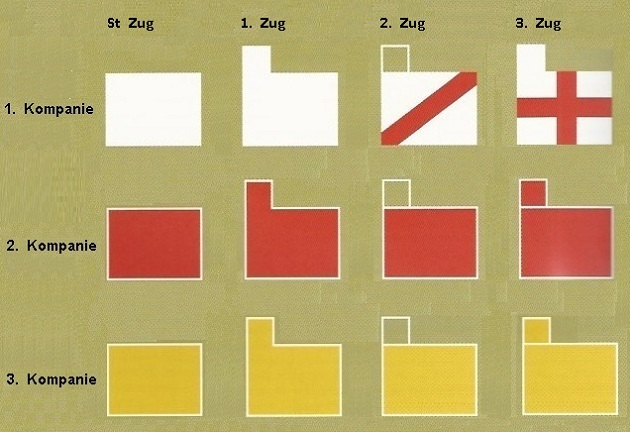
This example is the rear of Ferdinand 324.

schwere Panzerjäger-Abteilung 654 markings
These are the tactical signs and numbers used by s.Pz.Jg.Abt. 654 from 5 July to 23 August 1943. The “N” refers to the Abteilung commander Hauptmann Karl-Heinz Noak which was usually painted on the left front fender and on the rear hull. On 23 August 1943, s.Pz.Jg.Abt. 654 handed over all their Ferdinands to s.Pz.Jg.Abt. 653 and returned to Orleans, France to be re-equipped with Jagdpanthers. They later fought in NWE during 1944/45.
The striked out numbers indicate the 26 Ferdinands that were written off between 5-30 July 1943.
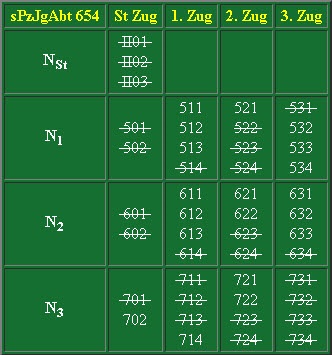
Schwere Panzerjäger-Regiment 656 from 5 July to 27 July 1943:
Kills: 502
Losses: 39
Kill ratio: 12.9:1
Day 1 of Zitadelle, 5 July 1943
At about 0100 hours the Soviet artillery began heavy harassing fire along the lines. At 0330 hours, German artillery began their heavy preparatory barge for the attack. The German Pioneers employed their Borgward B IVs to clear lanes though the Soviet mine fields. s.Pz.Jg.Abt. 653 Ferdinands and the 292. Infanterie-Division attacked towards Ozerki and Veselyi Berezhoi. s.Pz.Jg.Abt. 654 Ferdinands and the 86. Infanterie-Division attacked towards Maloarchangel’sk Station (5 miles north of Ponyri). Due to heavy artillery fire and very heavily mined terrain, the Borgward B IVs were only able to clear narrow lines through the minefields and they were not clearly marked. Many Ferdinands were disabled with broken tracks and idler arms. The shock from the mine explosions also damaged the Ferdinand’s two batteries which were not anti-shock mounted in the hull. The Ferdinand’s engines were under powered for its weight which made them easily overheated causing engine fires. Due to no self defense weapons, some crews opened the main gun breach and fired a MG 34 through the 88mm gun barrel. One would have to wonder what that did to the rifling inside the barrel and to the muzzle break.
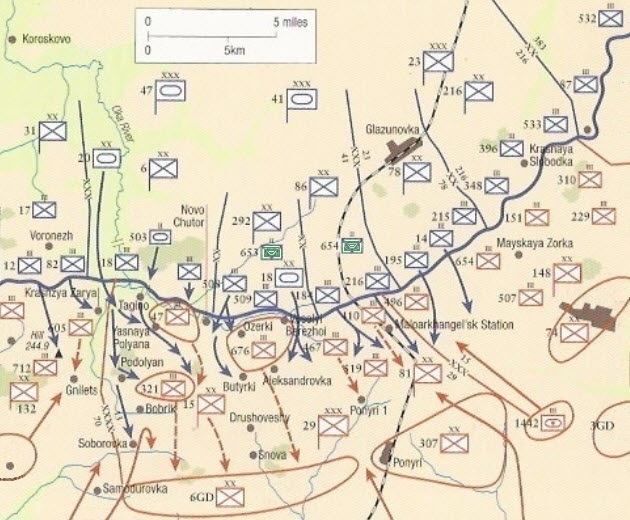
A column of Borgard B IVs passing a couple of Ferdinands in the Maintenance area. Note the front of a Ferdinand in the tree line at the right edge of the photo.

A Borgard B IV passing Ferdinand 134.

On the afternoon of July 5, s.Pz.Jg.Abt. 654 commander Hauptmann Karl-Heinz Noak was severely wounded by shrapnel. He was transferred to the engine deck of this Pz.Kpfw. III to be transported to the rear for medical aid.
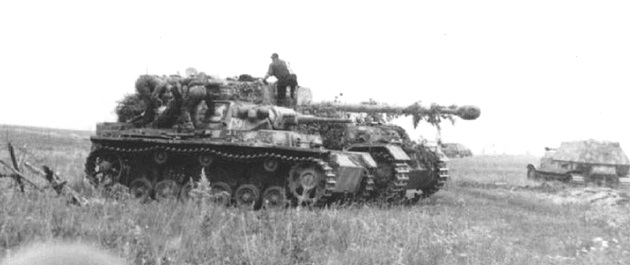
A Ferdinand passing a Borgard B IV hung up in the Soviet anti-tank trenches.

Film: Elephant Panzer in Action
A burning KV-1 is seen through a Ferdinand gunsight.

A Ferdinand passing a knocked out KV-1.
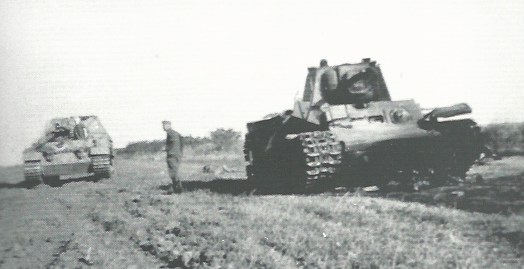
On July 6, Hauptmann Johann Spielmann, the original commander of 1./s.Pz.Jg.Abt. 653 was severely wounded by an antipersonnel mine while dismounted and guiding his Ferdinand 101. Oberleutnant Hellmut Ulbricht became the temporary acting commander of 1./s.Pz.Jg.Abt. 653.
Ferdinand 101 during a maintenance halt in July 1943. Is this Ulbricht, maintenance personnel or a crewman?

Oberleutnant Hellmut Ulbricht
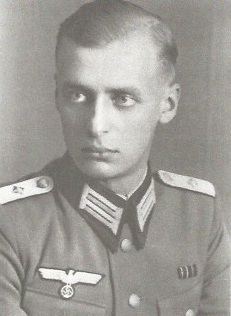
Ferdinands first encounter with SU-152s
On July 6 near Ponyri, a group of s.Pz.Jg.Abt. 654 Ferdinands advancing with the 292. Infanterie-Division exchanged fire with T-34’s of the Soviet 129th Tank brigade but unexpectedly encountered their armoured match. The Soviet 1442nd Self-Propelled Artillery Regiment equipped with SU-122s and at least one battery of SU-152s engaged the Ferdinands. One 1./s.Pz.Jg.Abt. 654 Ferdinand (5??) was knocked out by a SU-152 at 800m (874.89 yards). The SU-152’s shell had penetrated the Ferdinand’s side armour and it was set on fire. On July 8, the Ferdinands of 3./s.Pz.Jg.Abt. 653 encountered a number of SU-152s and during that engagement three Ferdinands were knocked out.
A column of Ferdinands moving up to the front. The nearest Ferdinand is number 112. Note the jerry can mounted on the rear. The painted white cross on the can indicates it contains drinking water to prevent cross contamination.
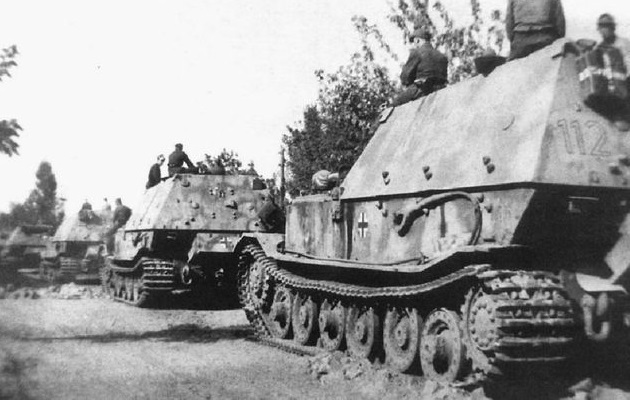
Ferdinand 112 was disabled and being examined by Soviet troops.

A loss of two Ferdinands due to a communication failure
On July 7, the 78. Infanterie-Division (which was on the left flank of s.Pz.Jg.Abt. 654) requested that two Ferdinands be attached to one of its forward units to defend an exposed position. After the Ferdinands reached the position, the infantrie unit had pulled back during the night without informing the Ferdinand crews of their movement. During the night, soviet infantry (probably from the 74th Rifle Division) captured one of the Ferdinands intact including its sleeping crew. The second Ferdinand while trying to retreat from the area got stuck in a muddy ditch and had to be abandoned.
An unlucky Ferdinand
A Borgward B IV has started a minefield clearing mission when a Soviet heavy artillery shell scored a direct hit on the carrier. The carrier’s 350kg (772 lbs) explosive charge detonated and the explosion blew apart the nearby Pz(Fkl)Kp. 314 Pz.Kpfw. III controller panzer. Most of the panzer’s hull was thrown over a rail enbankment and hit a Ferdinand on the other side. The airborne panzer hull cracked the Ferdinand’s gun barrel and wrecked the engine deck tearing apart the fuel tanks starting a fire which burnt it out. The Ferdinand probably belonged to s.Pz.Jg.Abt. 654 and was in the wrong place at the wrong time.
Note the Ferdinand in the background of this photo.

Ferdinand 322 before the battle.

This is a close up of the Ferdinand’s numbers. The faded or dirty black outlined numbers are very hard to see from a distance.

Ferdinand 333 (Commander Wachtmeidter Bruno Schardin) was surprised and captured by Soviet infantry near the town of Alexandrovka while providing security for German troops. The caption painted on the side translates as “German self propelled Ferdinand, whose entire crew was captured by soldiers of the 129th Rifle Division.”
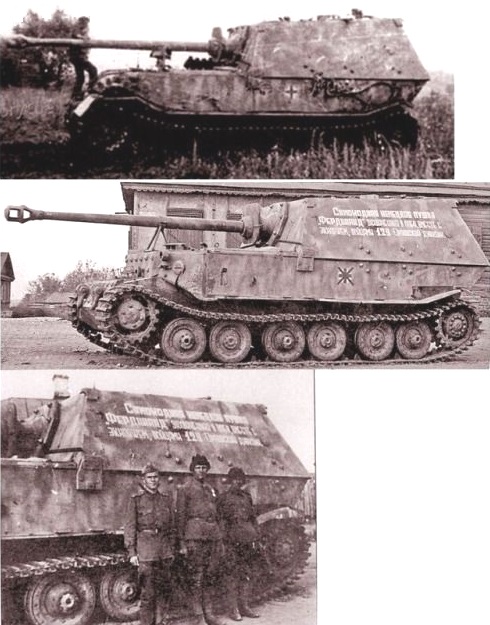
Soviet officers inspecting a disabled Ferdinand. Note the spare track links on the front fenders.

A line of s.Pz.Jg.Abt. 653 Ferdinands awaiting for maintenance and repairs.

Ferdinand II03 of s.Pz.Jg.Abt. 654 advancing along with the Borgard B IVs.
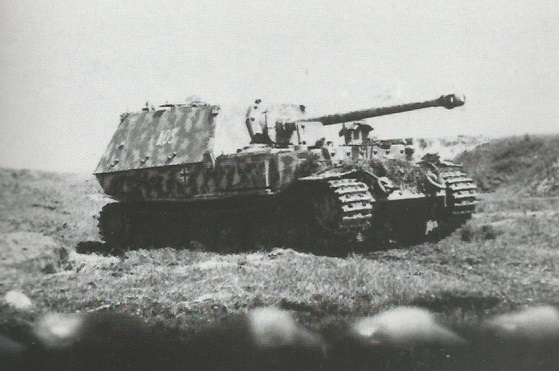
A few minutes after the above photo was taken, Ferdinand II03 was disabled by mines and its crew abandoned it.
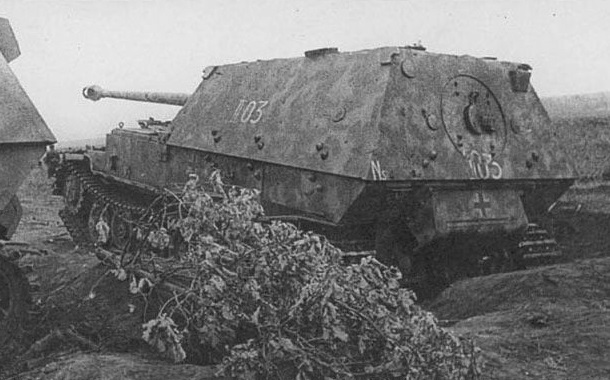
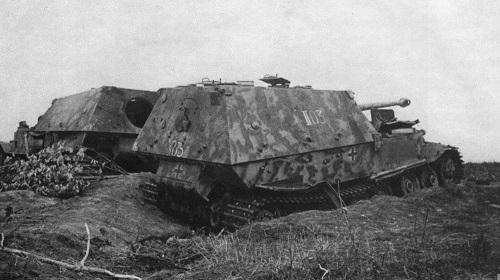

Ferdinand 501
On 13 July 1943, Ferdinand 501 of s.Pz.Jg.Abt. 654 (Commander: Oberleutenant Wilde) became disabled in a minefield in the area of Ponyri Station.
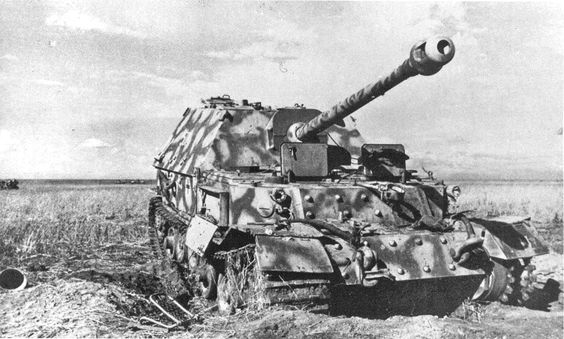

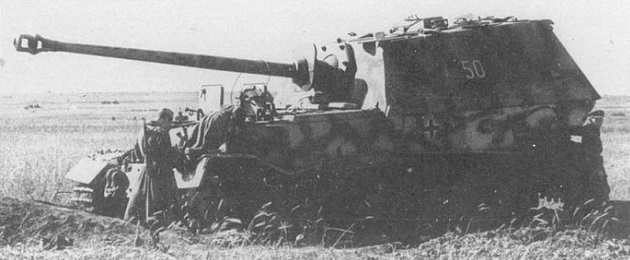
After the fighting ended, the Soviets restored it to operation condition and shipped it to the Red Army proving grounds at Kubinka (near Moscow) for testing and evaluation where it still remains today.
Kubinka museum display: Ferdinand 501
During the afternoon of 14 July 1943 during the battle for the Orel salient, the 36. Panzergrenadier-Division was hit by a frontal attack of about 400 Soviet tanks of the 1st Guards Tank Corps. Ferdinands of s.Pz.Jg.Abt. 653 with AT elements of the 36th Infantrie-Division were rushed forward to counter the attack. Despite the lack of time and familiarity of the terrain, a kampfgruppe of all 3 panzerjäger kompanies, under the command of Leutnant Heinrich Teriete succeeded in repelling the attack. A single Ferdinand claimed to have knocked out 22 Soviet tanks.
1./s.Pz.Jg.Abt. 654 Ferdinand 511 (Commander: Leutnant Hermann Feldheim) returns from action passing a disabled Panzer IV from Panzer-Regiment 35. Note the sections of camouflage netting draped on the hull side.
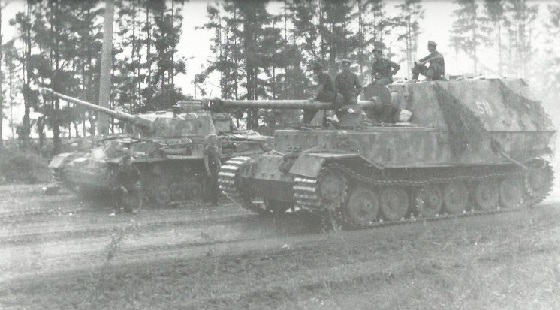
Ferdinand 511 is seen here on a railcar at Briansk for transport to Dnepropetrovsk. Feldheim was credited with 16 kills and although against regiment regulations the gun barrel carries 16 kill rings. He later commanded a Jagdpanther in NWE during 1944/45.
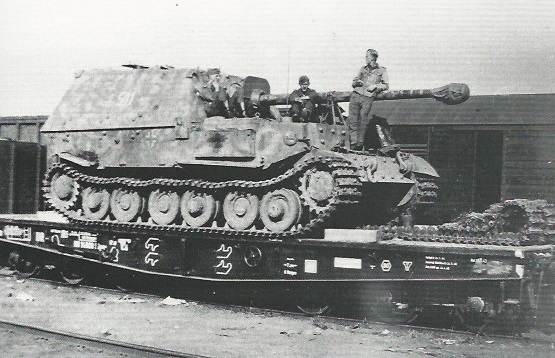
Ferdinand 513 parked next to a building.
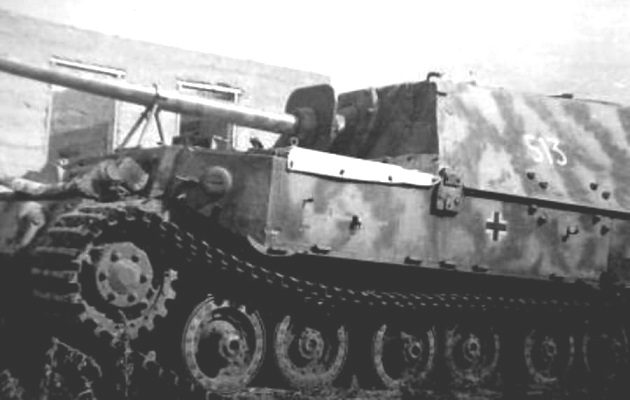
Ferdinand 521 (Commander: Leutant Pflug) moving into position.
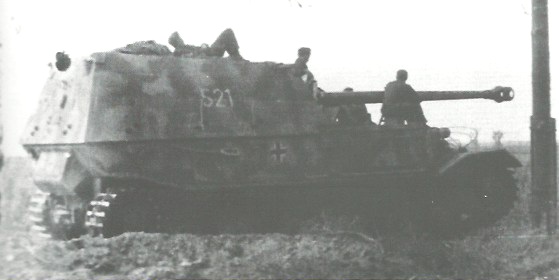
Disabled Ferdinand 531 (Commander: Oberfeldwebel Hensen) has a patch of white on its side. The marking could indicate that the Ferdinand is beyond repair but most likely the photograph is damaged.

Ferdinand 534 of 2./s.Pz.Jg.Abt. 654 (Commander: Feldwebel Huckstedt) parked in the woods.
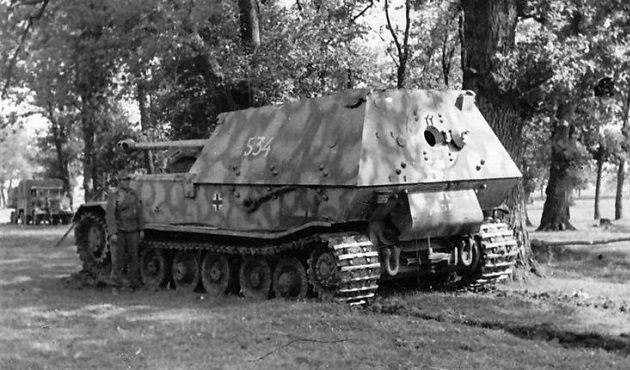
Ferdinand 612 (Commander: Leutant Heyn)


Ferdinand 621 (Commander: Leutant Petersen) being serviced by the Maintenance kompanie personnel. In the foreground is a Workshop Kubelwagen with toolboxes and other equipment.

The crew of Ferdinand 621 (formerly of 2./s.Pz.Jg.Abt. 654) placed a table on the engine over the main gun and are having a meal. After the s.Pz.Jg.Abt. 654 Ferdinands were transferred to s.Pz.Jg.Abt. 653, Feldwebel Müller of the Stab Kompanie took command of this Ferdinand. Note the tent setup on the front end of the railcar.


Disabled Ferdinand 623 (Commander: Unteroffizier Schmidt) is missing the mantlet shield.

Ferdinand 624 (Commander: Feldwebel Bohling) knocked out.

Ferdinand 624 being towed by at least two Soviet S-65 Stalinets tractors.
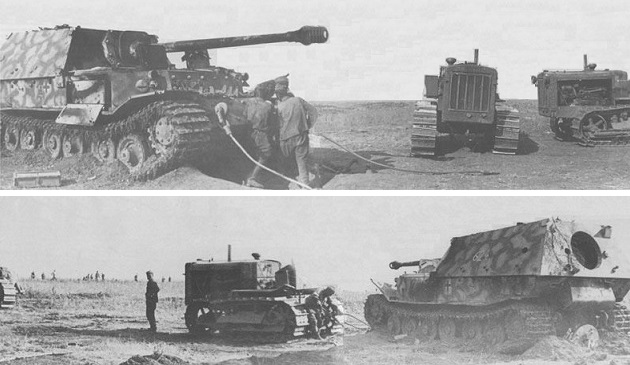
Ferdinand 624 on display in Gorky Park.

Ferdinand 632 (Commander: Oberfeldwebel Klimecki) being serviced in the field. A kubelwagen from the Maintenance section is parked nearby.

Ferdinand 634 (Commander: Feldwebel Land) disabled.

Ferdinand 722 (Commander: Oberfeldwebel Klarmeyer)

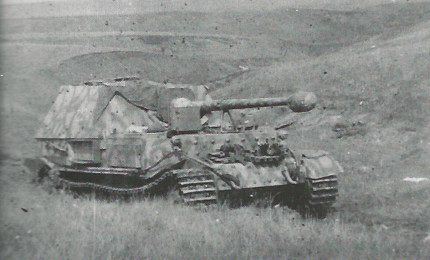

Ferdinand 723 (Commander: Oberfeldwebel Busch)

Ferdinand 723 is in the background and Ferdinand 712 is the closest.

Shot up Ferdinand 122 was retrieved from the Kursk battlefield and is on display in Gorky Park, Moscow. This was probably done for propaganda purposes to show the Soviet people that the Ferdinand was not immune to Soviet guns and were told that all the hits were achieved from long distances. Eventually, it was scraped.



A Ferdinand with a wounded driver. Note the bandage on his arm and head.
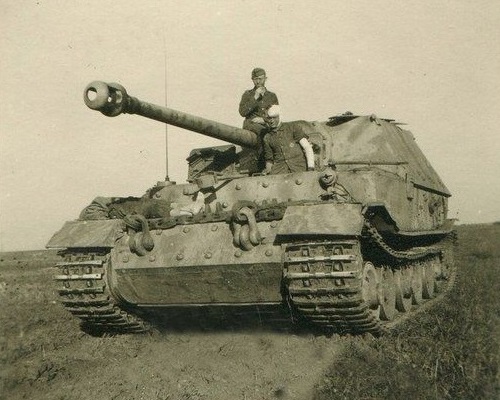
A Bussing-NAG type 4500 truck from the supply section reloads a 1./s.Pz.Jg.Abt. 653 Ferdinand with AT and HE rounds.
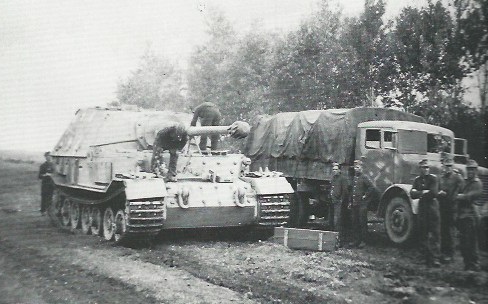
A Kfz.15 field car passes a disabled Ferdinand. The lower image is a close up of the front hull armour plate of the Ferdinand. Note the faded skull and cross bones between the center four bolts.
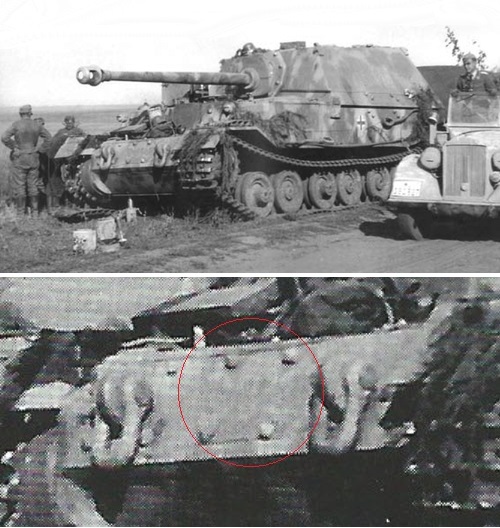
A house with a picket fence and a Ferdinand parked in the front yard.
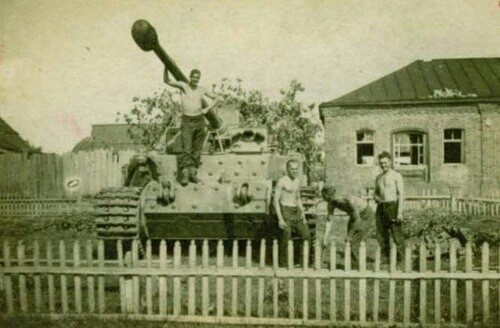
A column from a mixed kampfgruppe assembled from all kompanies moving into combat at Saporoshye. Note the spare tracks on the lead Ferdinand’s front hull.

During an attack against Soviet armour, Ferdinand 111 (Commander: Oberleutnant Hellmut Ulbricht) overheated and its engine caught fire. The crew extinguished the fire and later the recovery platoon towed it back to the rear for repairs.

On September 11, a mixed kampfgruppe of 12 Ferdinands and 13 Brummbärs load onto a train in Dnepropstrovsk to support units along the Ssinelnikovo-Pavlograd rail line. Note the panther which also took part in the fighting and the trackless T-34 in the background behind a farmer’s wagen.

With the front lines rapidly closing in on Germany, Ferdinands were sent to Nikopol on the bank of the Dnieper River in late September where 10 operational vehicles relieved the endangered Saporozhye bridgehead.
A Sd.Kfz. 7 towing a 88mm Flak 18 gun passes a Ferdinand of the 4th zug, 3rd kompanie, s.Pz.Jg.Abt. 653 while enroute to Nikopol.
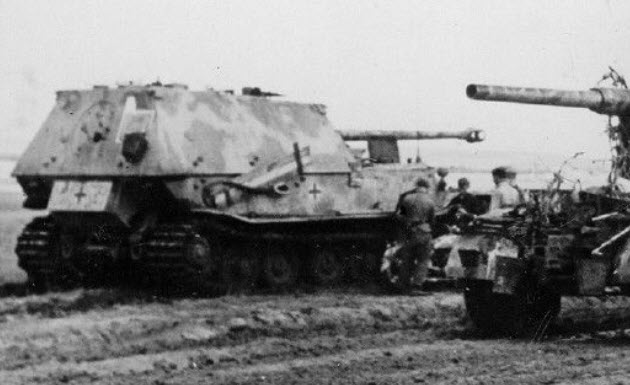
Four Ferdinands have boarded a 1,000 ton ferry to cross the Dnieper River to the Nikopol Bridgehead.

The “Pampas” emblems were applied to vehicles after incorporating left over Ferdinands within s.Pz.Jg.Abt. 653, October – December 1943.

1) Regiment Emblem
2) Stab (HQ) Kompanies of 653 / 216 Abt.
3) Second Kompanies of 653 / 216 Abt.
4) Third Kompanies of 653 / 216 Abt.
5) Regiment Supply Service
6) First Kompanies of 653 / 216 Abt. and 216 Abt. Workshop Kompanie
7) s.Pz.Jg.Reg. 656 Workshop Kompanie
Note: The numbers were not part of the Emblems.
Ferdinand 302 is on the right with barely visible black outlined numbers.

The Ferdinands were not able repell the Soviet advances and on October 13 were ordered to retreat. On October 15 after crossing the Dnjepr River on top of the hydro electric dam, the retreating Germans destroyed the Zaporizhstal steel plant almost completely; they demolished the big railway bridge, and demolished the turbine building and damaged 32 of the 49 bays of the dam.

This is Ferdinand 123 of 1./s.Pz.Jg.Abt. 653 after crossing the dam.

While withdrawing from the Saporoshye bridgehead, this bridge collapsed due to massive weight of this Ferdinand which belonged to 3./s.Pz.Jg.Abt. 653.

A Ferdinand from the 3rd Zug of the 1./s.Pz.Jg.Abt. 653 during the withdraw to Karatchev. Note the rolled up tarpaulin on the roof.

On November 20, s.Pz.Jg.Abt. 653 was fighting at the first defensive battle at the Nikopol bridgehead. The Ferdinands made some local successes at the villages of Maryevka (November 20) and Katerinovka (November 23) which stalled the Soviet offensives during the rainy season. During November 26-27, Kampfgruppe Nord ferdinand fought a successful engagement at Koschasovka and Miropol. 54 Soviet tanks were knocked out and 21 were credited to Leutnant Franz Kretschmer who recieved the Knight’s cross on 17 December 1943.
s.Pz.Jg.Reg. 656 Ferdinand status on 29 Novermber 1943:
– 4 operational
– 8 in short term maintenance
– 30 in long term maintenance
– 4 total loss
A second Soviet attack against the Nikopol bridgehead required another combat action on the eastern bank of the Dnjepr river by a kampfgruppe of Ferdinands commanded by Leutnant Franz Kretschmer.
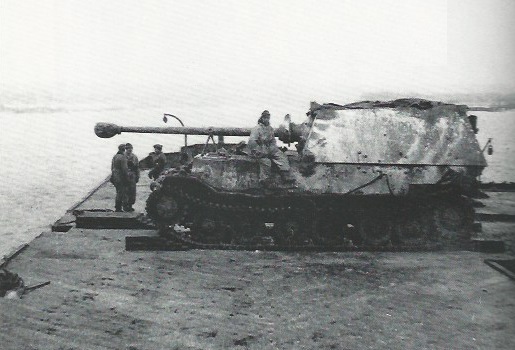
This is Oberleutnant Hellmut Ulbricht’s Ferdinand 111 on a railcar in Nikopol. Note the pennant attached to the radio antenna on the front hull.
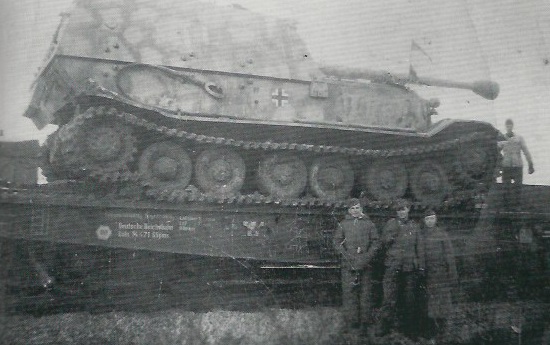
A whitewashed Ferdinand on a railcar. Some sort of tool box is hanging over the rear of the fighting compartment. Note the drums in front and behind the Ferdinand.
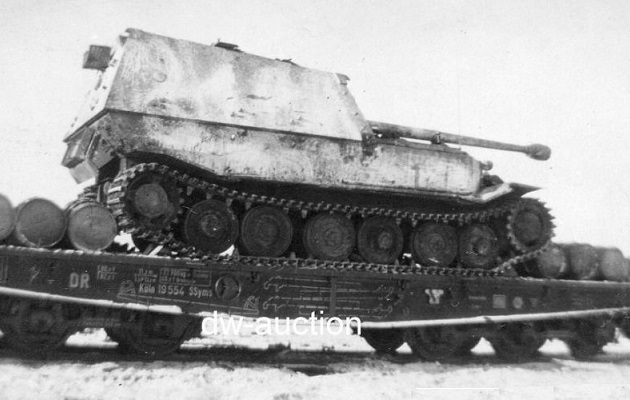
Ferdinand 234 with snow on the ground . . . Brrrrrrr


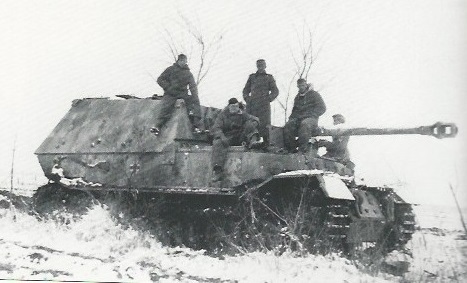
A Ferdinand dashing through the snow.
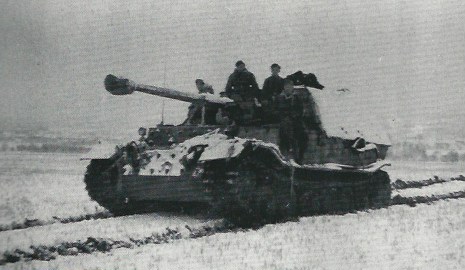
Ferdinand Upgrade
In November 1943, Hilter ordered the name to be changed from “Ferdinand” to “Elefant”. The OKH issued orders on 1 and 27 February 1944 which were received by the units on 1 May 1944 but actually came into effect on May 19th. It was not linked specifically to the upgade program, but was just a coincidence. Technically, for 5 months since the upgrades began they were still being called “Ferdinands” by the units.
Starting in December 1943, the 48 remaining Ferdinands were sent piecemeal to Nibelungenwerke at St. Valentine for rebuild and upgrade. Work on the first 8 Ferdinands began on 19 January 1944.

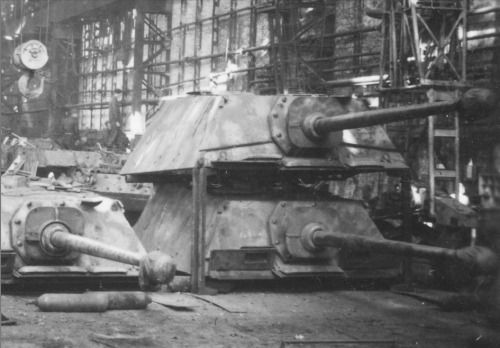
Beside repairs and maintanence, the following improvements were made:
1) Mixed Otto and Maybach engines in field-modified Ferdinands were all replaced with uniform Maybach HL 120 TRMs.
2) Two 5 litter carbon dioxide remote operated fire extinguishers were installed in the engine compartment.
3) Intercom was improved by backing up with a mechanical signalization system between the commander and driver.
4) 30mm armoured plate was welded to the driving compartment floor.
5) An additional ammunition bay was added to increase the number of rounds carried inside from 50 to 55.
6) A KwMG 34 machine gun position was fitted to the driving compartment glacis.
7) Round commander’s cupola replaced the rectangular hatch on top of the fighting compartment.
8) Narrow 600mm tracks were replaced with wider redesigned 640mm tracks.
9) The gun mantlet shield (an earlier field modification) was reversed so the seams and bolts faced forward.
10) Engine louver covers were redesigned and reinforced.
11) Additional sunshade was added to the driver’s periscope.
12) All exterior tools and spare tracks were relocated to the rear and more external stowage racks were added.
13) Reinforcement brackets were added to the fenders.
14) Headlight assemblies were removed from the front hull.
15) Zimmerit was applied to vertical and lower sections of the hull.

As part of the response to the Allied landings at Anizo, the German High Command ordered the schwere Panzerjäger-Regiment 656 to send the Sturmpanzer-Abteilung 216 (Brummbärs) and a kompanie of upgraded Ferdinands to Italy to counter the Allied forces. By 15 February 1944, 1./s.Pz.Jg.Abt. 653 commanded by Oberleutenant Hellmut Ulbricht received the first 11 Ferdinand upgrades out of the required 14 for a kompanie. The last three needed more work to become operational and would not be ready in time so it was decided to send what was available. The kompanie was transported by rail to Italy,
See post “Elefants in Italy 1944”
Feldwebel Fritz Schwarz holds a model of a Ferdinand that was created by members of 3./s.Pz.Jg.Abt. 653. This photo was taken at St. Polten (Austria) in February 1944. One wonders if he turned it over, would there be a Tamiya logo on the bottom. The model was most likely carved out of wood.

Four Ferdinands had a split rear hatch modification installed. An angled rain gutter was also added above the hatch.

These four Ferdinands were issued to the Stab (HQ) Kompanies on the Eastern front.
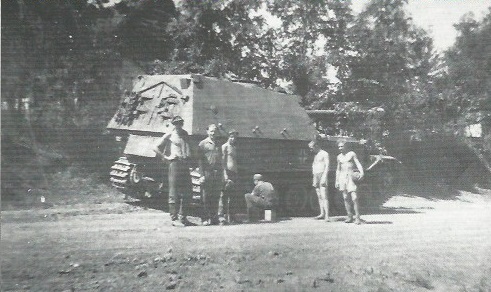
While the first 11 upgraded Ferdinands went to Italy, the rest went to 2./s.Pz.Jg.Abt. 653 and 3./s.Pz.Jg.Abt. 653 on the Eastern front. A new s.Pz.Jg.Abt.653 emblem was introduced in March 1944, the Nibelungenschwert emblem with wings of the Danube. The stab (HQ) kompanie had a plain one while the kompanies had their number painted in the circle. 1./s.Pz.Jg.Abt. 653 in Italy never adopted this emblem.

s.Pz.Jg.Abt.653, July 1944: The six unnumbered Elefants were reserves.
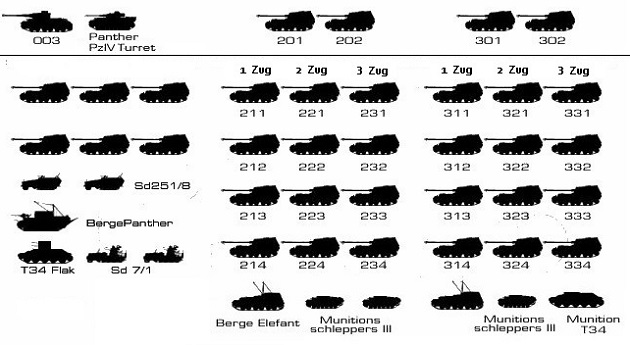
An Elefant parked in the woods somewhere in southern Poland.

These Elefants from 3./s.Pz.Jg.Abt. 653 are stuck in the mud awaiting recovery. The nearest has a couple of fuel drums on its engine deck for refueling.

3./s.Pz.Jg.Abt. 653 company commander Oberleutenant Franz Kretschmer commanded Elefant 301. Note the spare track on the front hull.

An Elefant receiving a new coat of camouflague in the Brzezany assembly area. All Elefants in theTarnopol area of operations had 3-color camouflague based on sand, green and red brown. Parked beside it is a Sd.Kfz. 3 Ford Maultier or the “Mule”.

Tiger I (P) 003
s.Pz.Jg.Abt. 653 requested and received only ONE Porsche Tiger VK 4501 (P) Fgst. Nr. 150013 Panzerbefehlswagen VI(P) in April 1944 which was commanded by Hauptmann Grillenberg. Behind it on the Ssyms rail car is a Bergepanther with a Pz.Kpfw. IV turret mounted.
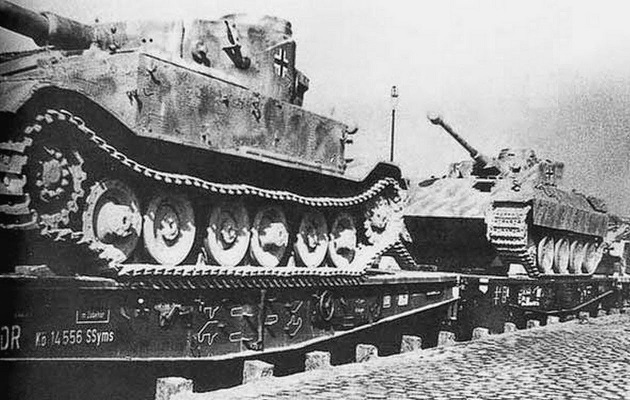
These two photos were taken during a stop in Lemberg (Lvov).

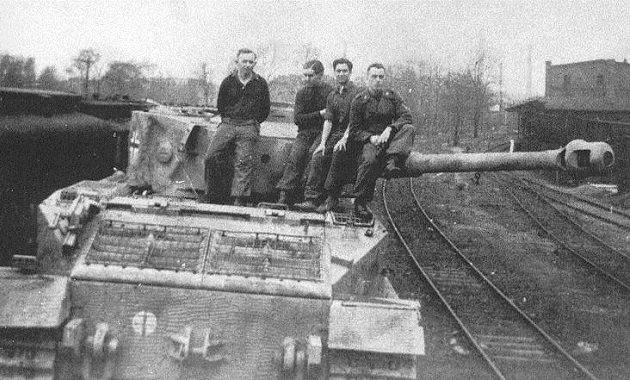
Before becoming operational, the maintenance kompanie made some modifications. An armoured plate was welded in front of the round openning for the MG on the front glacis and a deflector was welded over the top of the driver’s vision port.


This is the only Porsche Tiger VK 4501 (P) to have seen any combat during the war. It was reported as a loss during the withdrawal from the Soviet advance in July 1944.
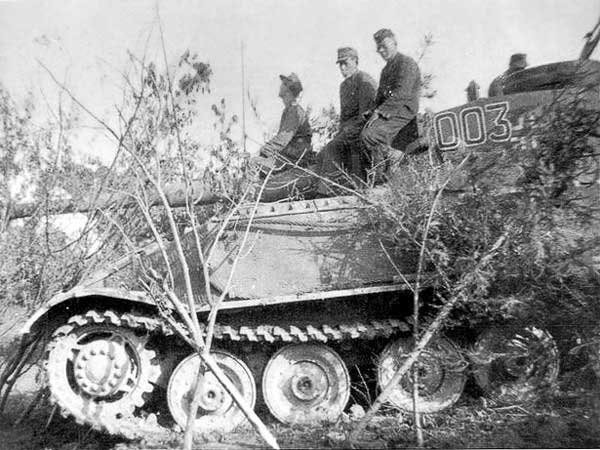
This photo shows the rear of the turret. Note the “Rommelkiste” (Rommelbox) style
turret storage bin.

Film: Ferdinand-Elefant Panzerjager VK45.01p Footage.
By 1 August 1944, s.Pz.Jg.Abt. 653 was down to only 12 operational Elefants. All the remaining Elefants were then combined into a single kompanie, 2./s.Pz.Jg.Abt. 653. While refitting at Krakow, two additional Elefants arrived from St. Polten, Austria and on 19 September 1944, the 2./s.Pz.Jg.Abt. 653 was assigned to the 17. Armee. At that time, 2./s.Pz.Jg.Abt. 653 in the Krakow/Tarnov area was the only Elefant kompanie left.
1./s.Pz.Jg.Abt.653 (returned from Italy) and the 3./s.Pz.Jg.Abt. 653 were sent to Fallingbostel then later to the Döllersheim Training Area where they were re-equipped with the Jagdtiger. Hauptmann (Captain) Helmut Ulbricht assumed command of the new support company.
On 15 December 1944, 2./s.Pz.Jg.Abt. 653 was renamed s.Pz.Jg.Kp. 614 and was assigned to the 4. Panzer-Armee. It occupied positions in the Kielce area and on 12 January 1945 the Soviets began a major offensive. By the end of January 1945, the unit had no fully operational Elefants due to major maintenance problems.
On 10 April 1945 in the area of Juditten, Tulen Kabilov (a highly decorated Kazakh sergeant of the 72nd Guards Rifle Regiment, 24th Guards Rifle Division) helped repulse a German counterattack. He threw an anti-tank grenade under an Elefant but was killed by the blast. Kabilov was posthumously awarded the Hero of the Soviet Union for his actions during the Battle of Königsberg.
Kampfgruppe “Ritter”
On April 22, Kampfgruppe “Ritter” was formed consisting of these elements:
– Stab of II./PzR 36
– PzKp z.b.V. “Dreyer” (10 Panthers with IR equipment)
– PzGKp (gep) “Uelzen” (SPWs with IR equipment)
– s.Pz.Jg.Kp. 614 (Four Elefants)
– part of II./PzR 36 (fighting as tank-killing infantry).
Ritter was most likely the commander’s name of II./PzR 36.
It was directed to enter into action at Zossen.
This Elefant went into action near Zossen (south of Berlin) and was abandoned in April 1945.

The fate of the last four remaining Elefants
One Elefant remained in Mittenwalde due to mechanical problems. One Elefant took up a firing position at the road fork to Löpten and remained there. In the besieged Berlin, the two remaining Elefants fought on the Karl-August-Platz and near the Holy- Trinity-Church. Both of the Elefants were captured by the advancing Soviets on 1 May 1945.

MODEL KITS
Ferdinand/Elefant
1/6:
Armortek Elefant – 2016
1/25:
GPM 354 Sd.Kfz.184 Ferdinand
1/35:
Cyber Hobby 6436 Ferdinand – Fahrgestell Nr. 150100 – 2007
Dragon 6126 Sd.Kfz.184 Elefant – 2000
(223, 322)
Dragon 6133 Sd.Kfz.184 “Ferdinand” – 2001
(124, 211, 302)
Dragon 6311 Sd.Kfz.184 Elefant – 2006
(124, 211, 302)
Dragon 6317 Sd.Kfz.184 Ferdinand – 2007
(113, 124, 624)
Dragon 6465 Sd.Kfz.184 Elefant w/Zimmerit – 2009
(323, 334)
Dragon 6495 Sd.Kfz.184 FERDINAND KURSK 1943 – 2012
(All numbers)
Italaerei 211 Tiger (P) Elefant – 1973
Italeri 211 German Tank Destroyer Jagdpanzer Tiger (P) Elefant – 1980
Italeri 211 Sd.Kfz.184 Panzerjager Elefant – 2010
Italeri 36501 (Also listed as 37501) World of Tanks Ferdinand – 2015
Nichimo R-3523 Elefant – 197x
Nichimo NR-3502 Jagdpanzer Elefant – 197x
Nichimo N-3502 Elefant – 1983
Revell/Italaerei H-2105 Jagdpanzer Tiger “Elefant” – 1974
Revell/Italaerei H-2105 Tank Hunter Tiger(P) “Elefant” – 1976
Revell 03254 Tank Hunter Sd.Kfz. 184 ELEFANT – 2017
Tamiya 35325 Sd.Kfz.184 Schwerer Jagdpanzer “Elefant” – 2012
Testors/Italeri 811 Kfz.184 Elefant – 1980
TOMY 3512 Jagdpanzer Tiger(P) Elefant – 1976
Zvezda 3563 Ferdinand – 199x, 200x
Zvezda 3653 German Tank Destroyer “Ferdinand” SD.Kfz. 184 – 2017
Zvezda 3659 German Tank Destroyer Elefant – 2019
1/48:
Bandai 8269 Jagdpanzer “Elefant” 88mm – 1973
Bandai 35433 Pz. Jag Elefant Sd. Kfz 184 – 1980
Bandai 0055596 Pz.Jag Elefant Sd.Kfz.184 – 199x
Fuman FM214 Pz. Jag ELEFANT Sd.kfz. 184 – 198x
Gaso.line GAS50139K Jagdpanzer Tiger(P) Elefant
Tamiya 32589 German Heavy Tank Destroyer Elefant – 2016
(102)
1/72:
Aurora/ESCI 6214 Jagdpanzer Elefant – 1977
Dragon 7201 Sd.Kfz. 184 Elefant – 2003
(322)
Dragon 7202 Sd.Kfz. 184 Ferdinand – 2003
(124)
ERTL 8300 German Tank Elefant – 1982
ESCI 8006 German Tank Destroyer Elefant – 1975, 1977, 1984
(501)
ESCI/ERTL 8360 German Tank Destroyer Elephant – 1989
ESCI/ERTL 8621 Elephant with German Troops – 1989
Gunze Sangyo GE-360 German Tank Destroyer Elephant – 1989
Hasegawa MB-111 German Pz.Jäg. Elefant – 1975
Humbrol HK72201 Elefant Tank – 1981
Italeri 7012 Sd. Kfz. 184 Panzerjäger Elefant – 2007
(102, 223, 124, 322)
Polistil 8006 German Tank Destroyer Elefant – 1976
Revell/ESCI H2305 Deutscher Jagdpanzer Tiger (P) “Elefant” – 1975
Soldat 8006 German Tank Elefant ESCI Spanish Ed. – 1978
Trumpeter 07204 Sd.Kfz. 184 Elephant – 2003
(223)
Trumpeter 07205 Sd.Kfz. 184 Ferdinand – 2003
(211)
Zvezda 5041 Sd.Kfz. 184 Ferdinand – 2018
(123, 501, 612)
1/76:
Fujimi WA13 German Heavy Tank Destroyer Elephant – 1974
Fujimi DS-5 Battle of Kursk Diorama Set – 1974
Fujimi 76005 German Heavy Tank Destroyer Elephant – 1994
Fujimi 76101 German Heavy Tank Destroyer Elephant – 2013
Porsche Tiger and Borgward IV
1/35:
Dragon 6869 Panzerkampfwagen VI(P)/Bergepanzer Tiger(P) – 2019
(003)
Italeri 278 Tiger-Ferdinand Porsche Version VK-4501 – 1994, 2003
Italeri 6565 VK 4501(P) Tiger Ferdinand – 2019
Cyber Hobby 6510 Pz.Kpfw. III Ausf. J Command Tank and Borgward IV Ausf. B – 2008

Reblogged this on The Tactical Hermit and commented:
Superb Obscure WW2 History.
I have mentioned this before, but as a Military Historical Fiction Writer if you have not read The Last Citadel by David L. Robbins about the Battle of Kursk, I HIGHLY Recommend it.
The Last Citadel on Amazon
LikeLike
Vous pourriez au moins donner les sources de cet article tirées du livre de M. Karl-Heinz Münch.
You could at least give the sources of this article taken from the book of Mr. Karl-Heinz Münch.
LikeLike
Your last image is NOT Berlin 1945. Its a mistake copied from a book. The Camouflage matches Gun 221 in Winter 1943
LikeLike